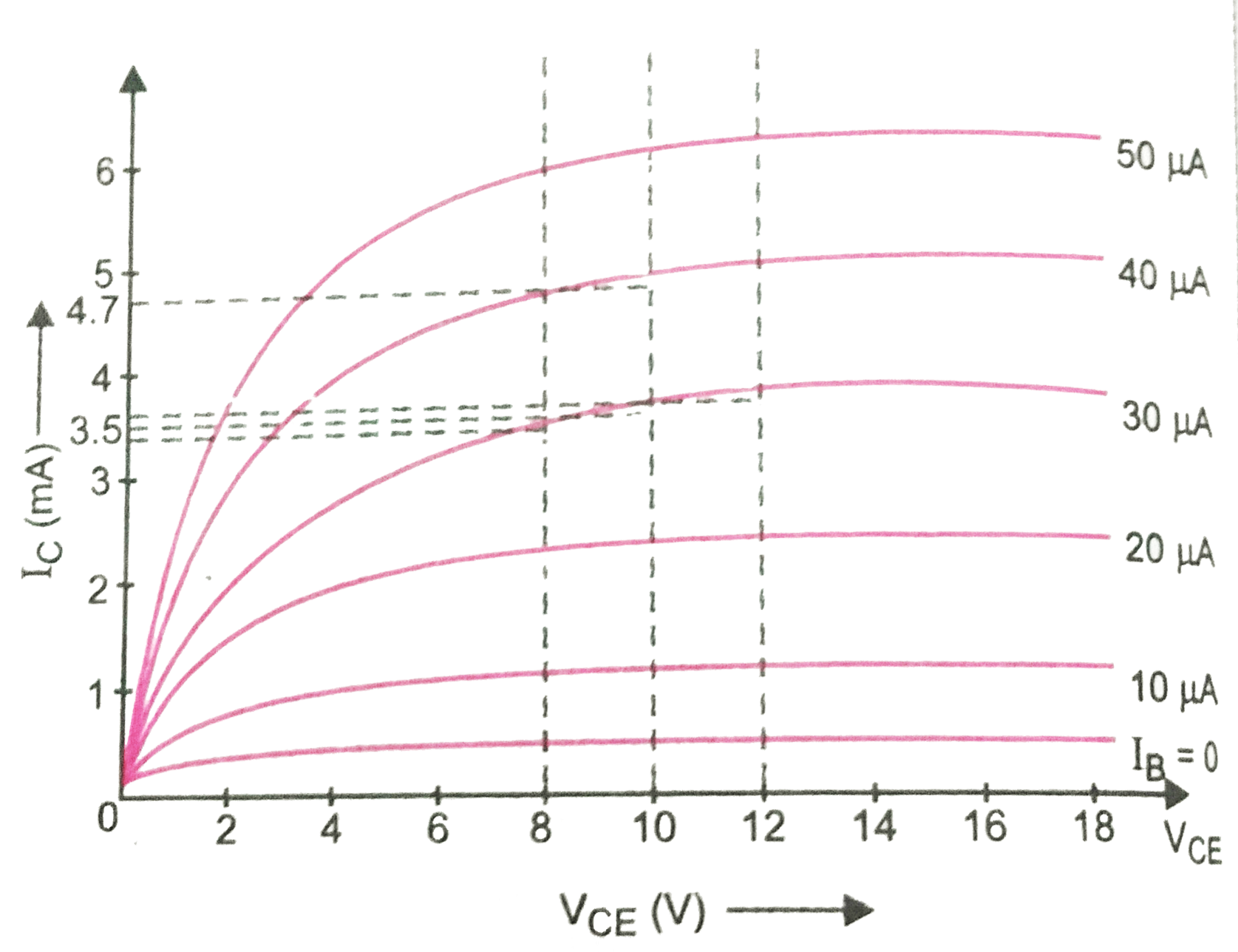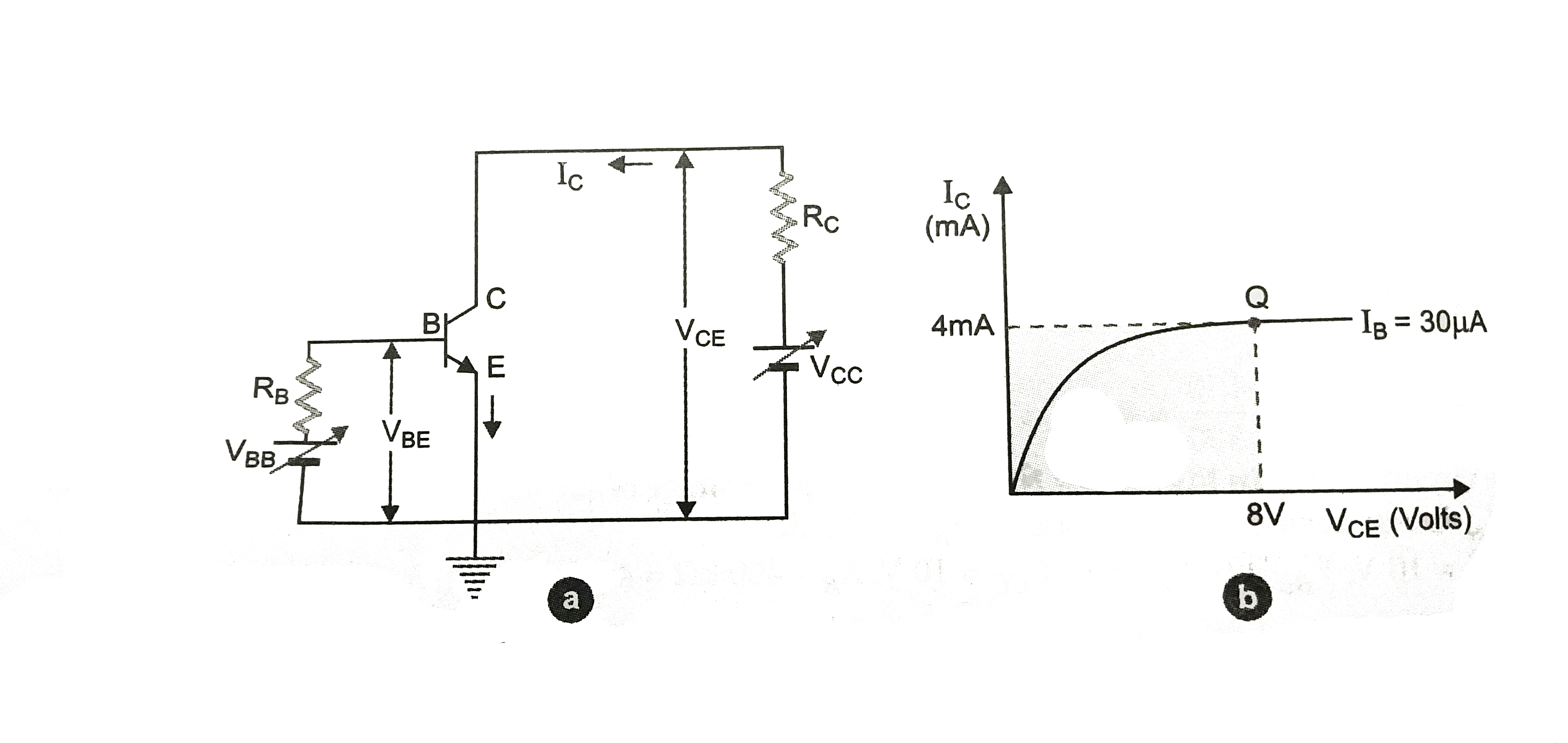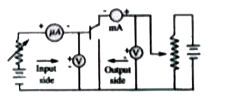Draw typical output characteristics of an n-p-n transistor in CE configuration. Show how these characteristics can be used to determine output resistance.
Step-by-Step Solution:
1. Understanding the NPN Transistor in CE Configuration:
- An NPN transistor has three terminals: collector (C), base (B), and emitter (E). In common emitter (CE) configuration, the emitter is common to both the input and output circuits.
2. Drawing the Output Characteristics:
- The output characteristics are plotted with the collector current (IC) on the y-axis and the collector-emitter voltage (VCE) on the x-axis.
- For different values of base current (IB), we draw separate curves:
- For IB = 10 µA, draw the corresponding curve.
- For IB = 20 µA, draw the next curve, which will be higher than the previous one.
- For IB = 30 µA, draw the highest curve.
- Each curve shows how IC varies with VCE for a constant base current.
3. Labeling the Graph:
- Clearly label the axes: IC (mA) on the vertical axis and VCE (V) on the horizontal axis.
- Mark the curves for different base currents (IB = 10 µA, 20 µA, and 30 µA).
4. Determining Output Resistance (R0):
- The output resistance (R0) is defined as the ratio of the change in collector-emitter voltage (ΔVCE) to the change in collector current (ΔIC) at constant base current.
- Mathematically, it can be expressed as:
R0=ΔVCEΔIC(at constant IB)
- To find R0, select two points on the same curve (for a constant IB) and measure ΔVCE and ΔIC between these points.
5. Calculating R0:
- For example, if you choose two points on the IB = 20 µA curve:
- Point 1: VCE1 = 5V, IC1 = 2mA
- Point 2: VCE2 = 6V, IC2 = 3mA
- Calculate:
ΔVCE=VCE2−VCE1=6V−5V=1V
ΔIC=IC2−IC1=3mA−2mA=1mA
- Now substitute into the formula:
R0=1V1mA=1000Ω=1kΩ
- An NPN transistor has three terminals: collector (C), base (B), and emitter (E). In common emitter (CE) configuration, the emitter is common to both the input and output circuits.
- The output characteristics are plotted with the collector current (IC) on the y-axis and the collector-emitter voltage (VCE) on the x-axis.
- For different values of base current (IB), we draw separate curves:
- For IB = 10 µA, draw the corresponding curve.
- For IB = 20 µA, draw the next curve, which will be higher than the previous one.
- For IB = 30 µA, draw the highest curve.
- Each curve shows how IC varies with VCE for a constant base current.
- Clearly label the axes: IC (mA) on the vertical axis and VCE (V) on the horizontal axis.
- Mark the curves for different base currents (IB = 10 µA, 20 µA, and 30 µA).
- The output resistance (R0) is defined as the ratio of the change in collector-emitter voltage (ΔVCE) to the change in collector current (ΔIC) at constant base current.
- Mathematically, it can be expressed as:
R0=ΔVCEΔIC(at constant IB)
- To find R0, select two points on the same curve (for a constant IB) and measure ΔVCE and ΔIC between these points.
- For example, if you choose two points on the IB = 20 µA curve:
- Point 1: VCE1 = 5V, IC1 = 2mA
- Point 2: VCE2 = 6V, IC2 = 3mA
- Calculate:
ΔVCE=VCE2−VCE1=6V−5V=1V
ΔIC=IC2−IC1=3mA−2mA=1mA
- Now substitute into the formula:
R0=1V1mA=1000Ω=1kΩ
Topper's Solved these Questions
- XII BOARDSBook:XII BOARD PREVIOUS YEAR PAPER ENGLISHChapter:XII BOARDSExercise:[Set- II]
Explore 4 Videos
- XII BOARDSBook:XII BOARD PREVIOUS YEAR PAPER ENGLISHChapter:XII BOARDSExercise:[Set-III]
Explore 3 Videos
- XII BOARDSBook:XII BOARD PREVIOUS YEAR PAPER ENGLISHChapter:XII BOARDSExercise:SET-III, DELHI BOARD
Explore 4 Videos
- SAMPLE PAPER 2019Book:XII BOARD PREVIOUS YEAR PAPER ENGLISHChapter:SAMPLE PAPER 2019Exercise:SECTION D
Explore 6 Videos
Similar Questions
Draw the typical input and output characterisitics of an n-p-n transistor in CE configurtion . Show how these characteristic can be used to determine (a) the input resistance (r1) and (b) current amplification factor (β).
View Solution(a) Draw the circuit arrangement for studying the input and output characteristics of an n-p-n transistor in CE configuration . With the help of these characteristics define (i) input resistance , (ii) current amplification factor .
(b) Describe briefly with the help of a circuit diagram how an n-p-n transistor is used to produce self-sustained oscillations .
View SolutionDraw the diagram of the circuit arangement used for studying the 'input' and the 'output' characteristics of an n-p-n transistor inits CE configuration. Briefly explain how these two types of characteristics are obtained and draw these characteristics.
(b) 'Define' the terms (i) Input resistance, (ii) Output resistance , (iii) Current amplification factor, for a given transistor.
View SolutionOutput characteristics of an n-p-n transistor in CE configuration is shown in the Fig. Determine

(i) dynamic output resistance (ii) dc current gain and (iii) ac current gain at an opererating point VCE=10V, when IB=30μA.
View SolutionDescribe briefly the functions of the three segments of n-p-n transistor.
View Solution(i) Draw a circuit diagram to study the input and output characteristics of an n-p-n transistor in its common emitter configuration. Draw the typical input and output characteristics.
(ii) Explain, with the hepl of a circuit diagram, the working of n-p-n transistor as a common emitter amplifier.
View Solution(i) Write the functions of three segments of a transistor.
(ii) Draw the ciruit diagram or studying the input and output characteristics of n-p-n transisfor in common emitter configuration . Using the circuit explain how input characteristics are obtained .
View SolutionConsider the circuit arrangnent shown in Fig. for studying input and output characteristics of npn transistor in CE configuration.
Select the values of R and R for a transistor whose VBE=0.7V, so that the transistor is operating at point Q as shown in the characteristics shown in Fig.
 Given that the input impedance of the transistor is very small and VCC=VBB=16V, also find the voltage gain and power gain of circuit making appropriate assumptions.
Given that the input impedance of the transistor is very small and VCC=VBB=16V, also find the voltage gain and power gain of circuit making appropriate assumptions.
View SolutionThe circuit diagram below shows n-p-n transistor in CE configuration. For this configuration, mark the correct statement(s).

View SolutionDraw the tramsfer characteristic curve of a base biased transistor in CE configuration. Explain clearly how the active region of the Vo versus Vi curve in a transistor is used as an amplifier.
View Solution

